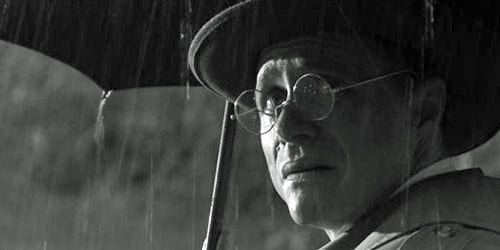
Bear in mind closely that I did not see any direct evidence to support these assertions. I cannot prove even now whether I was wrong in my hideous inferences. Yet the hints and portents, taken together, are persuasive.
For aeons, alien beings have inhabited Earth, wherein they have settled in caves in remote regions from Nepal to New England, keeping their existence a secret from all but a few humans, mining the planet for minerals they cannot find on their own far-flung worlds. The Mi-Go have left their mark on our religion, mythology, and folklore, but have for the most part kept to themselves—until now. Forced to find a home for legions more of their kind, the Old Ones are preparing to open a portal that will bend space and time to their will, and allow swarms of their genus to travel unfathomable distances to colonize our planet, and to embark upon the domination, and eventual annihilation, of mankind.
Seizing the most powerful lever of propaganda, the American motion picture industry, the Outer Beings from beyond the borders of the known cosmos seek to calm and distract moviegoers, while they carry out their insidious plan. The Unknown Ones’ diabolically ingenious stratagem is to tell… the very truth!. For by exposing their aim to invade Earth and enslave mankind within the confines of a fictional film safely compartmentalizes the horror as the subject for entertainment, and not the source of blood-curdling terror.
The Whisperer in Darkness adapts the 1931 short story by the same name by H.P. Lovecraft, the prescient seer whom literary historians have criminally relegated to the rank of a mere purveyor of pulp-friendly science fiction, horror, and fantasy. The tale follows the travails of Miskatonic University professor Albert Wilmarth as he investigates sightings of mutant corpses that wash up in waterways in Vermont after heavy flooding. His attempts to discover what, if any, truth lies behind these bizarre phenomena bring him into contact with amateur scientist Henry Akeley, who holds that creatures not of this earth are massing in the remote region of the Green Mountain State where he lives.
Wilmarth at first attempts to debunk this theory, and his outspoken views on the subject bring him a notoriety frowned upon by the university administration. As evidence mounts, however, he decides to pay a visit to Akeley in Vermont, where he quickly finds himself at odds with the fearful and suspicious local populace. A series of shocking revelations soon follow that shake his easy faith in science and threaten his very sanity.
Produced through an infernally clever process dubbed Mythoscope—which combines the adoption of a slight frame flicker with traditional effects such as miniatures, puppets, and suggestive lighting in order to mimic the cinematic conventions and appearance of beloved horror films of the ’30s—The Whisperer in Darkness engenders nostalgia for the golden age of film, distancing viewers from the all-too-real threat facing them at this very moment.
Most misleading of all is the film’s supposed low budget, an allegation designed to invite skepticism about the production. In fact, The Whisperer in Darkness boasts an excellent script, builds suspense and dread slowly, and convincingly presents the ages-old battle between credulity and rationality, captured well by a debate between Wilmarth and the author of sensational books on unexplained phenomena.
True, much of the cast are not well known or have labored mostly as character actors, yet they turn in excellent performances. Barry Lynch, veteran of episodic television, imbues Akeley with supernatural glamour and creeping horror, while Matt Foyer lends academic turned reluctant sleuth Wilmarth the appropriate clumsy, yet dogged determination. Young Autumn Wendel shines as a farm girl who sees through the machinations and plots of the adults around her.
In order to disguise the film’s origins in the unfathomable distances of space, the Outer Beings have founded a production company (The H.P. Lovecraft Historical Society), helmed by a pair of middle-aged dabblers in film, purported director-writer Sean Branney and co-writer Andrew Leman, who are also credited with The Call of Cthulu—created in Mythoscope in 2005, in the style of a silent picture. (This title is available on the provocatively named online service Hulu.) The Mi-Go seem to have been manipulating these hapless pawns into cloaking their nefarious plans with Lovecraftian productions since their high school days.
A companion DVD devoted to extras offers a glimpse into the pedestrian, even banal workaday production of The Whisperer in Darkness, further undermining the picture’s dreadful veracity. These materials are well worth perusal for the hints they provide to viewers attentive to the truth. For example, and perhaps foolishly, the would-be authors of our destruction let on that the latest computer techniques augment the effects of the vaunted Mythoscope process! What other sophisticated artistry, far beyond the skills of the ostensible makers, went into the creation of this picture?
And yet perhaps the Old Ones have made a slight miscalculation, for the film offers valuable information on their intelligence, powers, and technology. Know your enemy. Watch The Whisperer in Darkness — while there’s still time.

![Call for Papers: All Things Reconsidered [MUSIC] May-August 2024](https://www.popmatters.com/wp-content/uploads/2024/04/all-things-reconsidered-call-music-may-2024-720x380.jpg)



